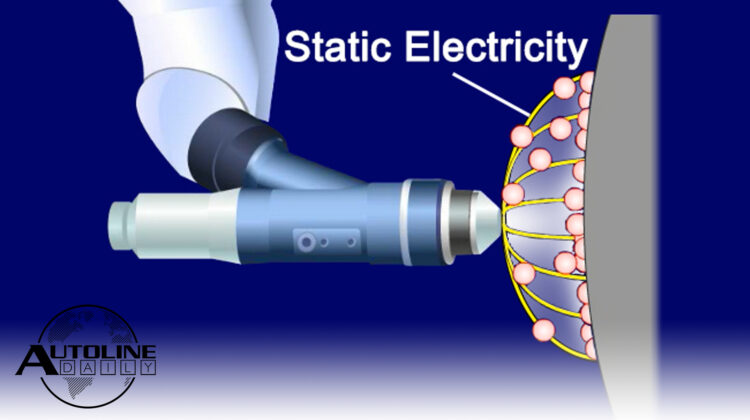
Listen to “AD #2792 – UAW Workers Worried About Lockdown; GM Hopes EVs Bring in New Buyers; Toyota Develops Airless Painting” on Spreaker.
Follow us on social media:
Runtime: 9:08
0:07 LMC Automotive Predicts Global Sales Fall
0:57 UAW Workers Especially Worried About Lockdown
1:20 Parts Shortages Could Make Customers Angry
2:13 Chinese Market May Have Bottomed Out
2:52 GM Hopes EVs Bring Buyers Back to the Brand
3:52 Toyota Develops Airless Painting System
5:30 What Makes Honda’s CR-V Hybrid Unique
6:52 IIHS Says Drivers Need to be Kept Engaged
8:01 Ford Helps Keep Cars on the Road
Visit our sponsor to thank them for their support of Autoline Daily: Bridgestone.
This is Autoline Daily, the show dedicated to enthusiasts of the global automotive industry.
LMC AUTOMOTIVE PREDICTS GLOBAL SALES FALL
As you all know, the world is fixated on the coronavirus, and the auto industry knew it was just a matter of time before it felt the impact. Now LMC Automotive is putting some numbers on it. LMC says global sales will fall by four and a half percent this year. That translates into a drop of 4 million vehicles. But it also warns that things could get worse. And if they do, LMC says sales could drop by another 2 to 3 million vehicles. Just to put some color on those numbers. That is the equivalent of closing 30 assembly plants, about 15 engine plants, 15 transmission plants, at least a dozen stamping plants, and the operations of thousands of suppliers.
UAW WORKERS ESPECIALLY WORRIED ABOUT LOCKDOWN
UAW workers are especially concerned. If there’s a lockdown or they have to self quarantine, they can’t work from home. And they don’t get paid if they don’t work. Automakers are rushing to put more hand sanitizers in plants, but as you all know, there’s a shortage of them. Many workers are bringing their own sanitizers from home.
PARTS SHORTAGES COULD MAKE CUSTOMERS ANGRY
Meanwhile, Morgan Stanley says sales in the U.S. could drop to only 15.5 million vehicles this year, down from 17 million last year. It also predicts Tesla will lose about 50,000 sales and set a new price target for its stock of $480. Yesterday Tesla closed at $634. JD Power is warning car dealers that they will face shortages of service parts which could lead to a lot of dissatisfied customers. It says that at first customers will be understanding of the shortages because of the coronavirus, but those shortages will persist well after the health crisis has subsided. And it says that in August, customers will start to get really frustrated that there aren’t enough parts to fix their cars.
CHINA MARKET MAY HAVE FINALLY BOTTOMED OUT
Bloomberg reports that the Chinese market probably bottomed out and expects sales to start to recover this month. But in a warning that shows we’re not going to get over this crisis in another month or so, the China Association of Automobile Manufacturers warns that the car market will not get back to normal until the third quarter this year.
GM HOPES EVs WILL BRING BUYERS BACK TO THE BRAND
One of the reasons that General Motors is so gung-ho on building battery electrics is that they could bring back buyers who walked away from GM years ago, or who never bought a GM car in the first place. Mary Barra, GM’s CEO, says that three quarters of the people who buy Chevrolet Bolt EVs are new to General Motors. She says they’re as passionate about their Bolts as Corvette owners are about their ‘Vettes. Mark Reuss, the President of GM, says the new generation of EVs “Allows us to re-set our brands.” General Motors lost an entire generation of buyers in the 1980s and 90’s when mediocre design and quality pushed them into the arms of other car companies. It lost another big group of buyers when it got bailed out by the government during the Great Recession. Very interesting that GM sees electric cars as the road to redemption.
TOYOTA DEVELOPS AIRLESS PAINTING SYSTEM
Toyota developed an airless spray painting system, which it claims is a first. The cylindrical end of the tip of the paint sprayer rotates. The force that spinning puts on the paint as it’s fed to the sprayer guides the paint into approximately 600 grooves on the tip. At the same time, the paint is hit with a voltage, which helps to atomize the paint. As the tip of the sprayer spins it flings the paint off and since it has a charge, the paint is attracted to the body of the vehicle. With this method over 95% of the sprayed paint sticks to the body. That compares to 60 to 70% with conventional air painting because air bouncing off the body panels takes paint with it. Toyota also says airless painting can reduce C02 emissions by 7% and paint collection devices can be made more compact, which will cut down on the size of the overall painting production line.
Be sure to tune in to Autoline After Hours today. We’ve got Gail May who oversees production of the Acura NSX supercar and Rob May, her husband, who’s developing the blueprint for Honda’s manufacturing electrification future. Paul Eisenstein from the Detroit Bureau will also be on the show. So join John and Gary for some of the best insights into the automotive industry.
WHAT MAKES HONDA’S CR-V HYBRID UNIQUE
If you follow us on social media, you probably noticed we got a chance to drive the new Honda CR-V Hybrid. Our driving impressions are embargoed until next week but here’s some specs on the crossover. It’s powered by a 2.0L, four-cylinder Atkinson cycle engine, two electric motors and a 1.4 kWh battery pack. The majority of the time it operates as a series hybrid but It can also operate as a parallel hybrid. The system provides 212 horsepower and 232 lb.-ft. of torque, which is more than the regular CR-V. And it’s fuel economy is rated at 38 MPG combined. While it looks pretty much the same as the gasoline-only CR-V, there are some differences. The Hybrid is offered with a 5-LED fog light design, a Blue Honda badge and a unique rear-bumper with hidden exhaust. On the inside, it comes with a hybrid specific gauge cluster, push-button gear selector, multiple drive modes, wireless phone charging and a redesigned center console. The CR-V Hybrid starts just under $29,000, while the top trim Touring model carries a $37,000 price tag.
IIHS SAYS DRIVERS NEED TO BE MORE ENGAGED
Partially automated, Level 2 driving systems like Tesla’s Autopilot and GM’s Super Cruise, help take the stress out of driving but the Insurance Institute for Highway Safety says they don’t do a good enough job of keeping drivers engaged. The more reliable and sophisticated these systems become, the harder it is for the driver to stay alert. So the IIHS says these systems need to do a better job at monitoring the driver and keeping them engaged in driving and the automakers should have limits for the types of roads the systems operate on. The IIHS recommends five levels of reminders for the driver if they’re not paying attention. The first warning should be visual, the second a visual reminder plus an audible or physical alert. The third warning should be all three. The fourth adds pulse braking. And finally, if the driver doesn’t respond, the vehicle should deploy hazard lights and slowly bring the vehicle to a stop. And it should prevent the driver from using the system for the remainder of the drive.
FORD HELPS KEEP CARS ON THE ROAD
Ford is making it harder for anyone to drive off the side of a road, day or night. It’s Road Edge Detection system uses a camera mounted under the rearview mirror to look out 50 meters or 164 feet ahead and 7 meters or 23 feet to the side of the vehicle. The system is able to pick out structural differences between the road and the road’s edge. And if needed, the vehicle will supply a small amount of steering support to keep the vehicle from going off the road. If more input is needed, the system will vibrate the steering wheel to get the driver to take over. Road Edge Detection is already available in Europe on the Explorer, Focus, Kuga and Puma.
But that’s it for today, thanks for watching and please join us again tomorrow.
Thanks to our partner for embedding Autoline Daily on its website: WardsAuto.com

John McElroy is an influential thought leader in the automotive industry. He is a journalist, lecturer, commentator and entrepreneur. He created “Autoline Daily,” the first industry webcast of industry news and analysis.





